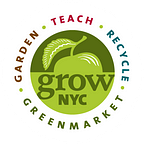Five Lessons Learned From Shopping in the Greenmarket
by Chef Peter Hoffman, Back Forty West
My eye-opening experience with the Greenmarket was in 1981. I was working as a line cook at Huberts in Gramercy Park and discovered a large black plastic bag that had been overlooked for over a week in our antique wooden reach-in. It was filled with young lettuces from Windfall Farms that had been delivered to the restaurant one evening while all the cooks were busy in service and then promptly forgotten. A similarly aged case arriving via the mainstream Hunts Point distribution network would have already been showing signs of rot, browned wet edges, flagging leaves, ready for the school guinea pig. This bag, though, was still in fine form, crisp, no sign of wilt, leaves fresh and pert. Amazed by this staying power, we committed to continue weekly purchasing from this local grower.
Lesson #1 Local does make a difference. Shortening the span of both time and distance between harvest and consumption immeasurably increases the quality of a meal.
An early farmer relationship I developed was with Alvina Frey, a farmer of German descent from Bergen County, New Jersey. When I remarked on how great her string beans were she revealed the field regimen required in order to have all the beans looking so uniformly petite. Unlike conventional production where a field or row are stripped entirely clean, Alvina insisted on daily passes through the same rows to pick only today’s best beans. Similarly, a trip to Berried Treasures Farm was the first time I heard Franca’s oft-repeated mantra over many decades that it’s the minerals she puts in the soil that give her strawberries, potatoes and beans such great flavor.
Lesson #2 You can taste the care. Seek out farmers making growing decisions that value food quality over ease of production, and low input costs to maximize profitability.
Growing up in New Jersey I knew there were different varieties of apples- Macintosh, Macoun, Cortland and Red Delicious, maybe a few more. When I happened on Locust Grove Orchard and saw box after box strangely labelled York Imperial, Newtown Pippin, Sheep’s Nose, Golden Russet, Northern Spy, a whole world opened up for me. Here were apples with stories behind them, of where they were discovered or who selected them and their special properties. Chip Kent, an 8th generation farmer, on the same Hudson Valley farmland was not bringing to market newly developed and patented varieties selected by focus groups for high sweetness/crispness coefficients but instead he set out on his table, a few boxes at a time, what had been grown on the farm for generations and was successful on that land, in that place.
Lesson #3 Variety matters; whether they are heirlooms or new selections, not all ingredients taste or cook up the same. Learn to discern and appreciate the differences between varieties.
Chefs have to strike a balance between the personal need for creativity and the business’s need for consistency. Calendaring menu changes with the actual seasonal forces may not always be in synch. No sooner has an asparagus appetizer been created and found its groove with the cooks and servers, than it’s gone for the season. Often another ingredient comes into season but sometimes there is no replacement. One fall day I raced to the market to purchase blueberries knowing that I was pushing my luck but not having figured out the next menu change. Visibly distressed at having missed the last pints not just for the day but for the year, a customer I only vaguely knew from shared market shops glanced over and said “You need to embrace the goodbyes, you know.” And I thought “What are you my therapist?” Marching away I realized she was right.
Lesson #4 Saying goodbye to vegetables is good practice for life. Ubiquity and constancy may be attainable with manufactured objects but don’t work out as well with food and relationships.
I used to buy stone fruit from Cole Orchards in northern New Jersey. Frank, Eleanor and their son Dave grew a broad diversity of trees and varieties so that their season extended further out than any other grower. Their white peaches were the most miraculous I had ever tasted. Old trees on perfectly drained sandy soil were the key to all that juice and sweetness he always told me. After Frank died, Dave and his mom ran the operation for a few years before Eleanor decided to sell the entire farm to a developer for subdivision and comfortably retire to Florida. We were heartbroken; Dave, not to have a future on that incomparable property; me to learn that it was too late to try and organize and save the farm. This stellar orchard, the multi–decade product of nature and nurture was destroyed forever to make way for a block of pre-fab (or not so fab) houses; a collective loss for our community that can never be regained.
Lesson #5 Shopping isn’t enough. While our weekly Greenmarket purchases go directly to farmers helping to ensure farm viability, there are market forces at play way larger than the exchange of goods for currency at Greenmarket. We need to intervene and protect our farmers and farmland in ways that the Invisible Hand of the marketplace never can.
Want to learn more about GrowNYC and our $40 for 40 campaign? Visit http://www.grownyc.org/blog/greenmarket-40-40.
